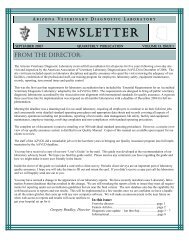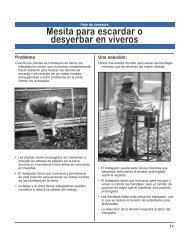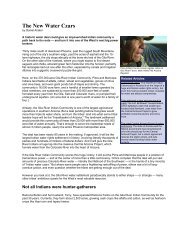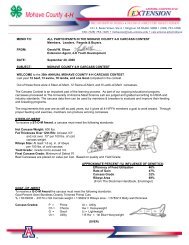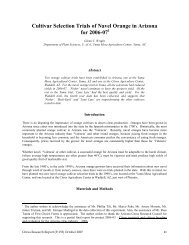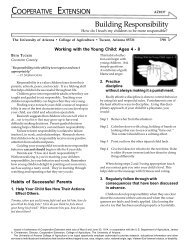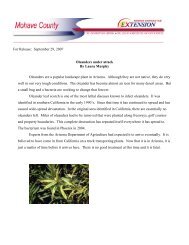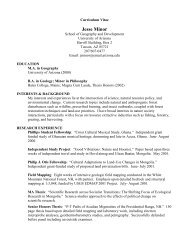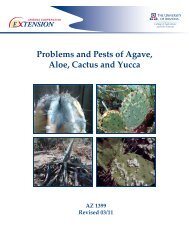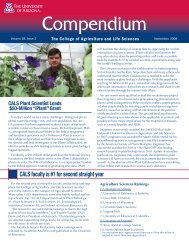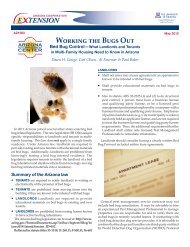Evaporative cooler water use - University of Arizona
Evaporative cooler water use - University of Arizona
Evaporative cooler water use - University of Arizona
Create successful ePaper yourself
Turn your PDF publications into a flip-book with our unique Google optimized e-Paper software.
Bill Witschi, the Water Systems Manager at the<br />
<strong>University</strong> <strong>of</strong> <strong>Arizona</strong>, suggests that bleed-<strong>of</strong>f should<br />
be about 1/3 makeup <strong>water</strong>. The rate could be lowered<br />
if no scale is observed forming on the <strong>cooler</strong> pads. 12<br />
13. If I decide not to install a bleed-<strong>of</strong>f valve beca<strong>use</strong><br />
it increases <strong>water</strong> usage, what can I do to prolong<br />
the life <strong>of</strong> the <strong>cooler</strong>?<br />
Thorough cleaning <strong>of</strong> the <strong>cooler</strong> is suggested to<br />
remove mineral deposits and scale build-up at least<br />
once during the cooling season. Additives to the <strong>water</strong><br />
supply also are available to help reduce scale build-up.<br />
Chemicals will not reduce scale build-up but they can<br />
increase the solubility <strong>of</strong> calcium and other minerals,<br />
thus allowing a lower bleed-<strong>of</strong>f rate, or they can<br />
combine with the calcium and produce a s<strong>of</strong>ter scale<br />
that is easier to remove. 13 Some <strong>cooler</strong> manufacturers<br />
do not recommend their <strong>use</strong> beca<strong>use</strong> they may damage<br />
the protective coating on the <strong>cooler</strong>. Caution should<br />
also be exercised about what chemicals are <strong>use</strong>d<br />
beca<strong>use</strong> these can be blown into the home during the<br />
normal operation <strong>of</strong> the <strong>cooler</strong>. 14 Ask your <strong>cooler</strong><br />
supplier. However, you may have to replace the <strong>cooler</strong><br />
sooner than you would if you <strong>use</strong>d a bleed-<strong>of</strong>f valve.<br />
14. Can <strong>cooler</strong>s be <strong>use</strong>d to circulate air only, without<br />
<strong>water</strong>?<br />
With cool air in the evening and nighttime hours,<br />
the <strong>cooler</strong> fan can be run with dry pads. This brings<br />
cool air into the home and circulates it without using<br />
<strong>water</strong>. Ceiling and/or oscillating fans <strong>use</strong>d in occupied<br />
rooms can help circulate the air for increased comfort.<br />
If <strong>cooler</strong> pads have been allowed to dry out, either<br />
through non-<strong>use</strong> or by circulating air only, it is advisable<br />
to run the pump and saturate the pads thoroughly<br />
before running the <strong>cooler</strong> fan. This ensures that <strong>cooler</strong><br />
air begins to circulate sooner and reduces the introduction<br />
<strong>of</strong> dust and pollen into the home.<br />
If you switch to air conditioning during the “monsoon”<br />
season and then switch back to the evaporative<br />
<strong>cooler</strong> as the relative humidity decreases at the end <strong>of</strong><br />
the rainy season, remember that standing <strong>water</strong> in the<br />
<strong>cooler</strong> pan is a stagnant pool. This <strong>water</strong> can become a<br />
good place for the growth <strong>of</strong> bacteria, even the bacteria<br />
that ca<strong>use</strong>s Legionnaire’s Disease. For safety it is best<br />
to drain the <strong>cooler</strong> if it will not be <strong>use</strong>d for several<br />
days. Alternatively, the <strong>water</strong> in the <strong>cooler</strong> pan can be<br />
treated with chlorine for at least 30 minutes before<br />
turning the <strong>cooler</strong> back on15 .<br />
15. How much does a new <strong>cooler</strong> cost?<br />
A new, completely installed 4500 CFM <strong>cooler</strong> costs<br />
about $700. Coolers are available for less money and<br />
for more money. This is an “average” figure.<br />
16. Should s<strong>of</strong>tened <strong>water</strong> be <strong>use</strong>d to operate an<br />
evaporative <strong>cooler</strong>?<br />
The sodium added to <strong>water</strong> by <strong>water</strong> s<strong>of</strong>tening will<br />
accumulate on the <strong>cooler</strong> pads and will become concentrated<br />
in the <strong>water</strong> reservoir. S<strong>of</strong>tened <strong>water</strong> also<br />
may increase the need for pad maintenance and the rate<br />
<strong>of</strong> rusting <strong>of</strong> metal <strong>cooler</strong> parts.<br />
17. What are ceiling vents?<br />
Ceiling vents or open windows are required to<br />
permit the exhaustion <strong>of</strong> the air blown into the home by<br />
the blower. Unlike refrigeration systems which recycle<br />
air within the home, <strong>cooler</strong>s blow large volumes <strong>of</strong><br />
cooled outside air into the living areas, and this air<br />
needs to be vented from the home.<br />
Ceiling vents make it possible to keep windows and<br />
doors closed while the <strong>cooler</strong> is running. This is helpful<br />
for security. These prefabricated exhaust ducts are<br />
installed in the ceiling in several rooms <strong>of</strong> the home.<br />
These exhaust air into the attic which must have an<br />
adequate amount <strong>of</strong> vents. UL tested ducts that automatically<br />
close in case <strong>of</strong> fire are available from <strong>cooler</strong><br />
equipment suppliers. The venting <strong>of</strong> ho<strong>use</strong> air into the<br />
attic will also reduce the air temperature in the attic and<br />
thus the amount <strong>of</strong> heat gain in the living area <strong>of</strong> the<br />
home.<br />
Homeowners could also benefit from window<br />
stops, available from most hardware stores for almost<br />
all types <strong>of</strong> windows. With stops in place, windows<br />
cannot be opened beyond a certain point chosen by the<br />
homeowner, usually 6 to 8 inches. they are easy to<br />
install, very inexpensive, and discourage entry. Plants<br />
with many spines and thorns, such as cactii and other<br />
desert species, can also be planted near windows to<br />
enhance security.<br />
18. How much does it cost to operate an evaporative<br />
<strong>cooler</strong>?<br />
Studies have indicated that the average annual<br />
cooling energy usage for a 1,600 square foot home is<br />
approximately 6,000 kilowatt hours for refrigeration<br />
and 1,500 kilowatt hours for evaporative cooling.<br />
If electricity costs were 10 cents per kilowatt hour<br />
(a sample cost), the average annual cost would be<br />
$600.00 for a refrigeration system versus $151.00 for<br />
evaporative cooling. However, the cost <strong>of</strong> <strong>water</strong> must<br />
<strong>Arizona</strong> Cooperative Extension • 5



